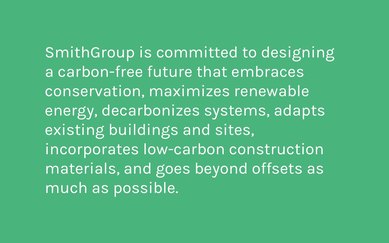Addressing the Climate Emergency: Our Commitment
SmithGroup has been a leader in sustainable design since the term was first coined. As planners and designers of the built environment, we have a responsibility and an opportunity to mitigate and adapt to the worst impacts of climate change. In 2007, we adopted the 2030 Challenge committing to pursue progressive energy targets across our practice to achieve net-zero energy design by 2030. While we have made strides, we realize that 2030 is imminent and there is a deep need for increased progress and leadership to help us meet this critical timeframe.
We must rethink how we are addressing climate change because we are in the midst of an urgent and growing climate crisis. The adverse effects of an already altered climate continue to intensify—from unprecedented heat waves, droughts and wildfires to increased flooding, coastal erosion and habitat loss. These shocks are having a growing impact on the communities we work with, economically, environmentally and socially. In addition to reducing carbon emissions, our design work must help our communities become more resilient to climate impacts.
While the climate crisis is enormous, the construction and operation of buildings and the built environment accounts for nearly 40% of global carbon emissions. The impact we can have as a firm and profession is tremendous. Designing a carbon-free and more resilient future will require leadership from every employee within our firm. SmithGroup is committed to rise to this challenge, leveraging our passion for innovation and our multi-disciplinary structure to advance climate mitigation and adaptation in all our work.
ACTION STEPS:
To put this aspiration into action, SmithGroup must think and design differently, with an intersectional approach to solve the interrelated risks of our communities. The need for holistic solutions at all scales of design and construction has never been more pressing, and we will take the following actions to meet that need:
- Achieve the operational energy use reduction targets of the 2030 Challenge, by leveraging a performance-based design workflow.
- Integrate performance modeling in our design process to maximize passive design approaches. Incorporate life-cycle cost analysis to justify energy-efficient systems.
- Conduct a robust risk analysis process at the start of each project that identifies the social, economic, and environmental context, needs and impact of the project.
- Prioritize on-site renewable energy, largely photovoltaics, in our designs. If on-site renewable systems cannot be initially afforded, design infrastructure to be solar-ready.
- Offset the carbon intensity of our built designs by recommending to our clients, partners for and investments in renewable energy and reforestation, ensuring our transition to a circular economy for the built environment.
- Decarbonize systems by avoiding design solutions utilizing fossil fuels, accelerating the transition to a clean energy economy.
- Incorporate infrastructure for electric vehicles in our designs to support a rapid transition to electrified transportation.
- Specify wood products only from sustainably managed forests and promote reforestation in our design solutions.
- Seek-out the adaptive-reuse of our building stock. When it comes to reducing embodied carbon, the greenest building is one that has already been built.
- Consider embodied carbon when selecting materials and systems, favoring products that embrace the circular economy. Leverage Life Cycle Assessment tools in our process.
- Advocate to our clients and the industry on the vital role we play in mitigating and adapting to the climate crisis, embracing the power of design to influence the behavior.
- Emphasize an interdisciplinary design approach that seeks to make our built work more sustainable and resilient, advancing the AIA’s holistic Design Excellence Framework with its balanced emphasis on equity, ecology, water, economy, energy and human health.
- Collaborate with our industry peers and partners to advance shared goals, frameworks and approaches for our climate mitigation and adaptation work. We need to lead together – not for individual competitive advantage, but for collective results.
- Reduce the carbon impacts of our own operations, embracing conservation, measuring our carbon footprint, and promoting a culture of sustainability.
